Tools to manage pests and diseases
Cultural practices to manage pests and diseases (1st step tools)
Organic farmers aim at creating diverse and ecologically stable farming systems and enhancing the plants’ natural defence mechanisms. The goal is a robust, healthy crop plant. They give first priority to prevention of pest and disease development instead of direct control measures. At the same time, this approach enhances biodiversity, protects natural resources and favours natural control mechanisms. This avoids costs for pesticides, residues on the crops, and negative impacts on the environment.
Tool 1: Choice of tolerant or resistant crops and varieties
The use of crops and varieties tolerant or even resistant against common pests and diseases is an effective measure to lower risks of pest and disease damage. In organic farming, the selection of varieties with partial resistance or field tolerance to pests is practical and even preferable to high-level resistance. There are more commercial varieties with disease resistance than are known for pest resistance. Therefore, for pest resistance, the local knowledge of farmers and advisers about the characteristics of traditional and local crop varieties is of high value. Even ‘resistant’ varieties need to be adapted under local climatic conditions for effective resistance.
Tool 2: Timely planting
Planting should be scheduled so that the most susceptible time of plant growth does not coincide with the life stage of pest or disease inoculum that damage the plant. Timing of seeding and planting is used to avoid invasion by migrants, or the oviposition period of particular pests, and the introduction of disease in the crop by insect vectors (like aphids and psyllids). In addition, it is used to synchronize the pest or disease attack with its natural enemies, with weather conditions that are adverse for the pest, disease pathogens or with the abundance of alternative hosts. This timing needs special knowledge of the pest or disease pathogen and when it is likely to attack.
Tool 3: Soil fertility management
The enhancement of soil fertility plays an important role in pest and disease control. A fertile soil enhances plant health and even triggers the immune reaction of plants. Soil fertility has to be improved by using crop rotations, cover cropping, green manure, application of compost and manures, and mulching:
- Besides the beneficial effect on soil fertility, crop rotations are important to avoid pests and diseases incubating in the crop field. An interval of 1 to 3 years between crops of the same family grown on the same field breaks the life cycle of the pathogens. The minimal duration of the interval depends on the disease’s or pest’s persistence in the soil. Some diseases stay dormant as spores in a field for many years (e.g. bacterial wilt stays infectious for at least 2 years, late blight up to 4 years, and Fusarium species up to 6 years). Many pests like rice stem borer or plant-parasitic nematodes will easily die from starvationi if crops are not available in the following year. If soil-borne pests and diseases are a problem, improved fallows for at least one season can also be applied.
- Cover crops and green manures, besides feeding the soil and improving its organic matter content, can reduce pests by confusion and diseases by biofumigation. Pest species like aphids, root flies or weevils will not find the crop plants due to the intercrop causing olfactory confusion.
- Application of compost can help control plant pests and diseases through (i) successful amendment of the soil with insect pathogenic microorganisms (ii) antibiotic production by beneficial microorganisms and (iii) activation of pest-tolerance or disease resistant genes in plants by essential nutrients of composts.
- Application of organic mulches can, in special cases, reduce pests like root flies, cutworms or aphids by olfactory confusion or by hiding the preferred places for egg laying. In special cases, they reduce diseases by altering the immediate environment or by reducing raindrop splash-dispersal of some soil-borne diseases. However, organic mulches might also enhance some fungal diseases by enhancing soil moisture.
Tool 4: Conservation tillage
Conservation tillage aims at creating a suitable soil environment for growing crops and conserving soil, water and energy resources through reduction in the intensity of tillage and retention of plant residues. Plant residues serve as additional organic matter incorporated in the soil. Conservation tillage practices improve soil structure and enhance micro-, meso- and macrofauna in the soil. This additional diversity of organisms at the same time can improve plant health through competition, parasitism, or antibiosis with the soil-borne pests and diseases.
Tool 5: Field hygiene and sanitation
- The use of disease free seeds and planting materials is a very effective tool to prevent development of seed-borne pests and diseases. Certified seeds are normally clean, but if such seeds are not available to the farmers, the seeds should be treated before use to eliminate seed-borne diseases (see hot water treatment).
- Sanitation of existing crops, especially perennial crops should be done regularly. Poorly managed or abandoned perennial crops can result in build up of pest and disease problems. All damaged plant materials and rotten fruits from the ground must be either burned or deeply buried at least 50 cm deep.
- Pruning eliminates inoculum in perennial crops. All infected branches or shoots should be cut at least 20 cm below the visible damage. Pruning also improves aeration and light exposure to the crown, which contribute to prevention of diseases.
- Regular cleaning of all the tools used for pruning infected plants or gardens is important, especially in the case of bacterial and viral diseases. If possible, alcohol (>70 %) can be used to disinfect the tools or heating the metal parts of tools over a fire.
Plenary discussion on cultural practices for pest and disease management
Invite the farmers into a discussion about the different cultural practices that can enhance the health of a crop. Identify local examples and discuss how each mentioned practice prevents infections. Ask the farmers that have implemented such a practice to share their experiences in terms of its advantages and disadvantages. Alternatively, you may visit a farmer who practices already practicing these methods to share his/her knowledge.
Habitat management to control pests and diseases (2nd step tools)
Organic farmers make use of habitat management practices like conservation biocontrol, intercropping and trap cropping to encourage natural enemies of pest and disease causing organisms. For improving habitats, only non-host plant species of important pests and diseases should be chosen (e.g. avoiding plant species of the Brassica family in case of Turnip mosaic virus or Solanaceae family in case of late blight).
Habitat management also includes the adjustment of the environment around and within the field to improve air circulation (e.g. pruning trees and bushes limiting the air circulation in the main wind direction and avoiding dense crops). In contrast to pest management, the possibilities to reduce diseases by habitat management are more limited. However, the practices are also helpful to stabilize the entire system.
Tool 6: Conservation biocontrol
The natural enemies of pests are other organisms (fungi, bacteria, viruses, insect predators, and insect parasitoids) which kill pests—therefore, they are ’friends of the farmer’ as they help to control pests. Hence, many pest species can be managed by enhancing the efficacy and abundance of the existing natural enemies. This can be achieved through modification of the environment or existing practices—this is called ‘conservation biocontrol or conservation biological control’.
Conservation biocontrol is appropriate for organic agriculture because organic farmers use a minimum of disruptive broad-spectrum pesticides that otherwise would constrain the efficacy of natural pest enemies. The goal of conservation biocontrol is to diversify vegetation by adding plant species within and especially in the vicinity of crop fields. This will help natural enemies to find food sources like pollen, nectar and alternative hosts and preys and will satisfy their requirements for shelter (microclimate). There are many possibilities to enhance floral diversity within and along the boundaries of crop fields:
- Hedges - Use indigenous shrubs known to attract pest predators and parasitoids by offering nectar, pollen, alternative hosts and/or preys. Most flowering shrub species have this property. However, care should be taken to not use plant species known to be alternative hosts of pests or diseases.
- Beetle banks - Strips of grass in the neighbourhood of crop fields harbour different natural pest enemy groups like carabids, staphylinid beetles and spiders. In order to lower the risk of weeds and plants known as host plants of crop pests and diseases, one to three native grass species can be sown in strips of 1 to 3 meters.
- Flower strips - Use indigenous flowering plant species known to attract predators and parasitoids by offering nectar, pollen, alternative hosts and/or preys. Most flowering plant species have this property. However, care should be taken not to use alternative hosts of pests or diseases. Three to five native flowering plant species can be sown in well-prepared seed beds, arranged in strips of 1 to 3 meters on the boundary of the crop field. After flowering, seeds can be collected to renew the strip or create new ones.
- Companion plants - Natural pest enemies can also be attracted by companion plants within a crop. These companion plant species can be the same as used in the flower strips. A few (1 or 2 per 10 square meters) flowering companion plants within a crop serve as a ‘service station’ for natural pest enemies.
Tool 7: Intercropping (or mixed cropping)
Another approach for managing pests and diseases involves intercropping with other crops. The idea behind it is to have less concentrated areas of host plants which are less easy to be detected and colonized. Distantly related crop plants can visually or chemically interfere with specialist pests, making the habitat less favourable. Mixed intercropping systems where two or often more species are grown intermingled without distinct rows are very commonly used in the tropics. Row intercropping (growing two or more crops together in rows) and strip cropping (cropping by growing two or more species in strips) must be sufficiently wide to allow separate management regimes, but sufficiently close to influence each other. These types of mixed cropping systems have been widely investigated as they have great potential for reducing pest attacks.
The mixture of plants needs to be carefully chosen. Anise, chives, garlic, onions, radish, parsley and many other species are reported as good partners for intercropping. The example of the Mexican marigold shows the advantage of repelling pest insects like aphids and root nematodes, but attracts slugs and can have an herbicidal effect on cabbage.
Tool 8: Trap cropping
Trap cropping necessitates that the trap crop is more attractive to the pest as either a food source or egg laying site than the main crop. A particularly successful example is the push-pull trap cropping used in East African corn production.
Push-pull strategy is a simple cropping strategy, whereby Napier grass (Pennisetum purpureum) and desmodium legume (Desmodium uncinatum) are used as intercrops in maize. Desmodium is planted in between the rows of maize. It produces an odour that stem borer moths do not like and, therefore, ‘pushes’ away the stem borer moths from the maize crop. Napier grass is planted around the maize crop as a trap plant. Napier grass is more attractive to stem borer moths than maize and it ‘pulls’ the moths to lay their eggs on it. But Napier grass does not allow stem borer larvae to develop on it. When the eggs hatch and the small larvae bore into Napier grass stems, the plant produces a sticky, glue-like substance which traps them, and they die. So, very few stem borer larvae survive and the maize is saved because of the ‘push-pull’ strategy. In addition, the ground cover of desmodium within the maize field reduces witch weed (Striga spp.). Desmodium suppresses the witch weed by herbicidal compounds produced in the roots. Being a legume, desmodium also fixes nitrogen in the soil and thus enriches the soil.
Other examples of trap crops known to be applicable in Africa:
- Mexican marigold against slugs in vegetable crops.
- Indian mustard (Brassica juncea) to attract the diamondback moth (Plutella xylostella) in brassica crops.
- African tall variety of marigold (cv. Golden Age) reduces both eggs and larvae of the African bollworm (Helicoverpa armigera) when intercropped within tomatoes, Pigeon pea, chick peas, crotalaria, maize, tobacco, sorghum and sunflower are also attractive for the African bollworm during the flowering period. Therefore, planting this variety of marigold in strips or around a crop field can protect against African bollworm damage.
Sequential trap cropping uses an earlier planting of the same crop on reduced surfaces to attract pests. The early trap crops can either be destroyed to kill the pests or can easily be treated with biocontrol agents or insecticides (see chapter 4.2.3). For all kinds of trap crops, it is crucial to check them regularly to detect the presence of pests. In most cases, trap crops must be destroyed when they become severely infested, and before they are killed by the pest or have completed their lifecycle. This is important because the pests may move from the trap plants to the main crop. They can be removed and buried.
Tool 9: Biofumigation
Biofumigation is based on incorporating fresh plant mass into the soil, which will release several substances (mainly isothiocyanates) able to suppress soil-borne pests. Good effects of biofumigation are also seen against Sclerotinia and Phytium disease, damping off (Rhizoctonia solani) and bacteria rot (Erwinia sp.).
Plants from the Brassica family (mustard, radish, etc.) release large amounts of these toxic substances in the soil while decomposing and are considered the best material for biofumigation. Different mustards (e.g. Brassica juncea var. integrifolia or Brassica juncea var. juncea) should be used as intercrops on infested fields. As soon as mustards are flowering, they are cut and instantly incorporated into the soil by hoeing or ploughing. While incorporated plant parts are decomposing in a moist soil, nematicidal compounds are produced that kill nematodes. During the decomposing process, phytotoxic substances are released too. They can kill weed seeds, but they can also affect crop plants. Therefore, a new crop should only be planted or sown two weeks after incorporating plant material into the soil.
Tool 10: Crop isolation through quarantine practices
Knowledge about pest and disease distribution in the region must also be considered, especially for those considered epidemic. Sometimes isolation of farms or field locations far enough from pest or disease infested areas is needed for proper control. A regional crop rotation regime, working with other farmers, may be the only effective option to limit the spread of pests and diseases.
Discussion on habitat management for pest and disease control
Discuss all the measures of habitat management with the farmers. Invite the farmers to share their experiences on conservation biocontrol, intercropping and trap cropping. Visit a farm with a diverse natural habitat and identify plant species that may be promoted to control pests and diseases.
Direct control measures in pest management (3rd step tools for pests)
Direct control measures against pests include biological control (using other living organisms like bacteria, viruses or beneficial insects to control pests) and the application of insecticides of biological or mineral origin, pheromones for mating disruption, repellent agents as physical barriers and traps for mass-trapping. All measures are used as a last option for the control of pests when all methods used in preceding steps failed. For certified organic production, only agents of non-synthetic origin are permitted. One allowed exception is the use of synthetic pheromones because they are contained in dispensers and, therefore, do not come into contact with crops.
Sharing of experiences on direct control of pests
Invite the farmers to share their experiences on direct control of pests. Do they have experiences with direct control measures other than the use of synthetic pesticides? Which criteria do they consider relevant to ensure the success of direct control measures? How relevant is timing of the application? How is proper timing defined? Do they practice regular scouting of the pest prior to application?
Tool 11: Biological control of pests
Biological control implies using other living organisms, for example, natural enemies to control pests. Natural enemies help the farmer to control insect pests that eat crops and prevent them from causing economic damage. Biological control of pests is based on releasing mass-reared live agents such as bacteria, viruses, fungi, insect predators and insect parasitoids into crop fields to control pests for a brief or extended period. Biological control strategies are considered direct control measures that are employed when indirect measures are not sufficiently effective. However, not all commercially available biocontrol agents can be used in organic agriculture; for instance, genetically modified organisms are prohibited. Biological control is widely used in greenhouse crops, but is still limited in field-grown crops.
The best-known biocontrol agent used in field crops is the bacteria Bacillus thuringiensis var. kurstaki and B. t. var. aizawai against diverse lepidopteran pests, and the B. t. var israeliensis against mosquitoes. B. t. var kurstaki is produced in local factories in different African countries (e.g. South Africa, Kenya and Mozambique) and can be used against different pests (African armyworm, African bollworm, bean armyworm, beet armyworm, cabbage webworm, cabbage moth, cabbage looper, cotton leafworm, diamondback moth, giant looper, green looper, spiny bollworm, spotted bollworm, pod borers, tomato looper).
There are a few fungi known to be entomopathogenic. The best-known species are Beauveria bassiana (against termites, thrips, whiteflies, aphids and different beetles) and Verticillium (Lecanicillium) lencanii (against whiteflies, thrips and aphids). Many different products (mycopesticide) are on the market, but they are mostly designated to be applied in greenhouses. These entomopathogenic fungi need high air humidity to develop. To overcome this problem under field conditions, a few products are formulated with (plant) oil. The fungus Metarhizium anisopliae var. acridum is a fungal biocontrol agent specific to killing the species of short-horned grasshoppers. This fungus is widely distributed in Africa and causes local epidemics in grasshopper or locust populations under favourable climatic conditions. Its biological and physical properties make this fungus an ideal candidate for augmentative biological control. Spores of M. anisopliae var. acridum can easily be mass-produced. It is available either as dry spore powder or as oil miscible concentrate. The product is applied as an oil suspension and can be sprayed with usual equipment or aerial applications for large scale application. Usually, the control of locusts with this mycopesticide is implemented through either the government or through non-governmental organizations, which work directly with farmers that follow mainly participatory approaches. This might be the best way to make use of this biocontrol agent.
There are different other biocontrol agents known to be effective against pests:
- Granulosis viruses against lepidopteran pests such as Plutella xylostella Granulovirus against the diamondback moth, Cydia pomonella Granulovirus against the codling moth in apple.
- Entomopathogenic nematodes against different weevil species (e.g. Steinernema carpocapsae, Heterorhabditis bacteriophora).
- Insect predators such as ladybird beetles, predatory gallmidges, hoverfly larvae against aphids and psyllids.
- Insect parasitoids such as Trichogramma species against the African bollworm are bred in some laboratories in Africa against lepidopteran pests and aphids. A successful introduction of the neotropical parasitoid Apoanagyrus (Epidinocarsis) lopezi against the cassava mealybug (Phenacoccus manihoti) caused a satisfactory reduction of P. manihoti in most farmers’ fields in Africa. This is one of the success stories of classical biocontrol.
However, most of these biocontrol agents are not available to small-holder farmers in Africa. The reasons are the insufficient number of factories or farmers cooperatives producing the biocontrol agents, problems of a rapid distribution from the production factories to the users, and the susceptibility of most agents to heat.
Tool 12: Insecticides of vegetal or mineral origin
There are commercial organic insecticides available in many countries of Africa (e.g. neem, rotenone and pyrethrum). Most of them can be handcrafted by farmer cooperatives or by the individual farmers.
The neem tree (Azadirachta indica) originally comes from India, but today it is known all over Africa. The neem tree has over 100 compounds with pesticidal properties. The highest concentration of the most important compound azadirachtin is in the fruit, especially in the seeds. Neem acts as a broad-spectrum repellent, insect growth regulator and insect poison. Unlike most botanical insecticides, neem also has a somewhat ‘systemic’ effect. This means that plants can take up neem extracts through their roots and leaves, spreading the material throughout the plant tissues. For this reason neem can help control pests such as leaf miners. Neem products are effective against a wide range of pests: about 400 pest species are known to be affected by neem extracts. In spite of its broad-spectrum action, neem products generally do not harm natural enemies.
Neem products with high oil content are phytotoxic to some plants, meaning that plants may be burned when neem extract is used at a high dosage. Therefore, the extracts should be tested on a few plants before going into full scale spraying. At the same time, however, neem extracts are rapidly decomposed by sunlight. For this reason, commercial products usually contain a sunscreen that protects the extract from sunlight, allowing for a longer exposure to sunlight.
Recommendation to farmers about preparation of neem pesticides:
Neem pesticides can be prepared from the leaves or from the seeds. The leaves or seeds are crushed and mixed in water, alcohol or other solvents. For some purposes, the resulting extracts can be used without further refinement. Ground neem seeds (neem cake) or neem kernel powder is used as a soil amendment and is effective for control of nematodes. It is also used for control of stalk borers and to prepare water extracts, which are then sprayed onto plants. Neem cake has a considerable potential as a fertilizer and at the same time it will hinder nematode attacks of the crop roots (e.g. tomato). Put neem cake in the planting pit (200g per m2) and mix it with substrate. The neem cake will repel and even kill nematodes and other root pests. Insecticidal agents (azadirachtin) will be translocated to above-ground parts of the plant and help to get rid of pests there.
Pyrethrum is a natural insecticide derived from African Chrysanthemum cinerariaefolium flowers. They are perennial plants with a daisy-like appearance and white flowers. The plant is most productive at altitudes above 1600 meters and ideally in semi-arid conditions. On richer soils the insecticidal properties are reduced. The content of the active substances increases with altitude and cooler average temperatures. Pyrethrum extracts should not be mixed with lime, sulphur, or soap solutions during application since pyrethrum is broken down by both acid and alkaline conditions. In addition, pyrethrum extract is also rapidly broken down by sunlight. Pyrethrum is a broad-spectrum and contact poison for controlling pests on flowers, fruits and vegetables. It can be used to control most aphids, spider mites, thrips, whiteflies, African armyworm, African bollworm, cutworms, maize stalk borers and potato jassids.
Recommendations to farmers on preparation of pyrethrum pesticides:
Pyrethrum powder is made with dried ground flowers. Use pure or mix with a carrier such as talc, lime or diatomaceous earth and sprinkle over infested plants. To make liquid pyrethrum extract (mix 20g pyrethrum powder with 10 l water), add soap to make the substance more effective. Strain and apply immediately as a spray. For best effects this should be applied in the evening. Pyrethrum can also be extracted by alcohol.
Chillies and capsicum pepper have both repellent and insecticidal effects.
Recommendations to farmers on preparation of chilli pesticides:
To make the chilli extract: grind 200 grams of chillies into a fine dust, boil it in 4 litres water, add another 4 litres of water and a few drops of liquid soap. This mixture can be sprayed against aphids, ants, small caterpillars and snails.
Garlic has antifeedant (insect stop feeding), insecticidal, nematicidal and repellent properties. Garlic is reportedly effective against a wide range of insects at different stages in their life cycle (egg, larvae, adult). This includes ants, aphids, armyworms, diamondback moth, whitefly, wireworm and termites. Garlic is non-selective, has a broad-spectrum effect and can kill beneficial insects as well. Therefore, it should be used with caution.
Recommendations to farmers on preparation of garlic pesticides:
To make the garlic extract, grind or chop 100 grams garlic into 0.5 litre water. Allow mixture to stand for 24 hours, add 0.5 litre of water and stir in liquid soap. Dilute at 1:20 with water and spray in the evening. To improve efficacy, chilli extract can be added.
There are many other extracts of plants known to have insecticidal effects like tobacco (Nicotiana tabacum), yellow root (Xanthorhiza simplicissima), fish bean (Tephrosia vogelii), violet tree (Securidaca longepedunculata), and nasturtium (Nasturtium trapaeolum) which are traditionally used to control pests in Africa.
Precautions to farmers regarding use of plant extracts:
- Do not have direct skin contact with the crude extract during the process of preparation and application. Plant extracts like tobacco can also be very toxic to humans. Contact with plant extracts should be avoided in the eyes.
- Make sure that you place the plant extract out of reach of children during storage.
- Wear protective clothing (eyes, mouth, nose and skin) while applying the extract.
- Wash your hands after handling the plant extract.
Sulphur is probably the oldest known pesticide in use. In organic agriculture it is mostly used against plant diseases (see tool 18), but is also used against mites (acaricide). The acaricidal effect of sulphur is best at temperatures above 12° C. However, sulphur has the potential to cause plant injury in dry hot weather (above 32° C). It’s also incompatible with other pesticides. Sulphur should not be used together or after treatments with oil to avoid phytotoxicity.
Wood ashes from fire places can be efficient against ants, leaf miners, stem borers, termites and potato moths. Ash should be dusted directly on pest colonies and infested plant parts. The ash will dehydrate the soft bodied pests. Wood ashes are often used when storing grains to deter storage pests such as weevils.
Sharing of experiences on botanical mixtures for pest control
Choose the most commonly used botanical mixtures for pest control. Make a list of all materials that are needed to prepare them and let experienced farmers show others how they make them. Have they made any observations on the best time of application and the efficiency of the preparations?
Farmers should be encouraged to find out more about the efficacy of the different insecticidal mixtures by conducting their own farm experiments. They should set up their own plots as a group or individual farmers to be able to compare the effects between treated and untreated plants.
Tool 13: Pheromones for mating disruption
Pheromone dispensers release a sex hormone from the female insect. Few dispensers combined with special traps attract the male insects into the trap in which they get stuck. Pheromone traps are mostly used for monitoring pest insects but can also be used for mass-trapping. Several types of pheromone traps have been developed for monitoring African bollworms, cutworms, fruit flies, etc. and are widely used. However, in most parts of Africa, pheromone traps are not locally available and imported ones are not affordable to small-holder farmers.
Sex pheromones can also be used for mating disruption. Here, a high number of dispensers are installed in the crop (apple orchard, vineyard) to get a pheromone cloud within or over the crop. Male insects will then not be able to find the female and mating is, therefore, disrupted. Consequently no offspring will damage the crop.
Tool 14: Repellents against mammal pests
Not only insect, mite, nematode and slug species are known as pests, mammals such as elephants, monkeys, wild pigs, etc., destroy subsistence crops and threaten the livelihood of rural farmers across Africa. However, there are effective, nonlethal repellents known to drastically reduce the damage caused by elephants. The basic repellent agent is derived from Capsicum chillies or hot peppers (Pili pili kali). If crops are protected with elephant fences (at least 2.5 meters or 8 feet high with two parallel lines), squares of cloth or burlap soaked in a petroleum-based agent (motor oil) mixed with chilli powder can be fixed between lines. The very strong odour of capsicum peppers causes adverse physical reactions from elephants, including irritation of the eyes and burning sensations in the trunk. An additional approach is to produce chilli dung bombs with crushed chilli and animal dung. To give the mixture of chilli and dung a solid shape, the farmer may use a brick mould. The elephant bombs should dry for a day or two and then be placed in equal dispersal around the field. The farmer may set fire to them at nightfall. Elephant bombs will create a spicy smoke that keeps elephants out of farmers’ fields of maize, sorghum and millet. The same agent can be prepared against wild pigs, monkeys and other mammals.
Anise, chillies, chives, garlic, coriander, nasturtium, spearmint and marigold are plants known to have a repellent effect on different pest insects (aphids, moths, root flies, etc.) and can be grown as intercrop or at the border of crop fields. Marigold is especially known to deter root nematodes, while neem cake is known to deter mice.
Tool 15: Traps for mass-trapping of pests
Mass-trapping of pests is an additional control measure. They often can easily be built with cheap material.
Light traps can be used to catch moths such as armyworms, cutworms, stem borers and other night flying insects. Light traps are more efficient when placed soon after the adult moths start to emerge but before they start laying eggs. However, light traps have the disadvantage of attracting a wide range of insect species. Most of the attracted insects are not pests. In addition, many insects that are attracted to the area around the light traps (sometimes from considerable distances) do not actually fly into the trap. Instead, they remain nearby, actually increasing the total number of insects in the immediate area.
Colour and water traps can be used to monitor adult thrips. In some cases thrips can even be reduced by mass trapping with coloured (blue, yellow or white) sticky traps or water traps in the nursery or field. The colour spectrum of the boards is important for the efficacy of the sticky traps. Bright colours attract more thrips than darker ones. Sticky traps with cylindrical surfaces are more efficient that flat surfaces. They are best placed within a meter of crop level. Traps should not be placed near the borders of fields or near shelter belts.
Water traps should be at least 6 cm deep with a surface area of 250 to 500 cm2, and preferably round, with the water level about 2 cm below the rim. A few drops of detergent added to the water ensure that thrips sink and do not drift to the edges and escape. Replace or add water regularly.
Yellow sticky traps can be used to control whiteflies, aphids and leaf mining flies. Yellow plastic gallon containers mounted upside down on sticks coated with transparent car grease or used motor oil, is one such trap. These should be placed in and around the field at about 10 cm above the foliage. Clean and re-oil when traps are covered with flies. Yellow sticky boards have a similar effect. To use, place 2 to 5 yellow sticky cards per 500 m2 field area. Replace traps at least once a week. To make your own sticky trap, spread petroleum jelly or used motor oil on yellow painted plywood (size 30 cm x 30 cm). Place traps near the plants but faraway enough to prevent the leaves from sticking to the board. Note that the yellow colour attracts many insect species, including beneficial insects, so use yellow traps only when necessary.
Traps for house flies and fruit flies - Fruit flies and house or barn flies are attracted to fermenting fruit juice. The top of a plastic bottle can be cut off and inverted. A little sugar water or honey can be smeared around the rim of the bottle to further attract the flies, which will then enter the bottle containing sweet/fermenting fruit juice and be trapped. Fruit fly traps can be made locally using an ordinary jar with plastic containers or plastic bottles, in which holes have been cut. They can be used with food baits such as protein hydrolysates, yeast or sweet/fermenting fruit juice.
Tool 16: Physical barriers against pests
There are different physical barriers known to have a control effect on pests (like insect fences and fruit bagging). However, the most useful measure is fruit bagging.
Fruit bagging prevents fruit flies from laying eggs on the fruits. In addition, the bag provides physical protection from mechanical injuries (scars and scratches). Although laborious, it is cheap, safe and gives a more reliable estimate of the projected harvest. Bagging works well with melon, bitter gourd, mango, guava, star fruit, avocadoes and banana (plastic bags used).
Recommendations to farmers regarding fruit bagging:
Cut old newspapers to fruit size and double the layers, as single layers break apart easily. Fold and sew or staple the sides and bottom of the sheets to make a rectangular bag. Blow in the bag to inflate it. Insert one fruit per bag then close the bag and firmly tie the top end of the bag with sisal string, wire and banana fibre or coconut midrib. Push the bottom of the bag upwards to prevent fruit from touching the bag. For example, start bagging the mango fruit 55 to 60 days from flower bloom or when the fruits are about the size of a chicken egg. When using plastic bags (e.g. with bananas), open the bottom or cut a few small holes to allow moisture to dry up. Moisture trapped in the plastic bags damages and/or promotes fungal and bacterial growth that causes diseased fruits. Plastic also overheats the fruit. Bags made of dried plant leaves are good alternatives to plastic.
Direct control measures in disease management (3rd step tools for diseases)
Direct control measures against diseases include biological control (using other living organisms like parasitic fungi to control diseases) and the application of fungicides of biological or mineral origin. All measures are used as a last option for the control of pests, when all methods used in the preceding steps have failed. For organic production, only agents of non-synthetic origin are permitted. Even the often criticized agents copper and sulphur are of mineral origin so their use is also restricted.
Farmers should be encouraged to find out more about the efficacy of the different materials by conducting their own farm experiments. They should set up their own plots as a group or individual farmers to be able to compare the effects between treated and untreated plants. Be aware that some materials have preventive effects while others (like copper) have therapeutic effects. Therefore, the agents with preventive effects must be applied before disease attacks.
Discussion on direct control of diseases
Share experiences with the farmers on direct control measures against diseases. Find out the most commonly used botanical methods for disease control in the area in different crops. Invite experienced farmers to share their knowledge on preparing botanical preparations. Encourage discussion on timing and method of application and other criteria that are relevant for efficacy.
Tool 17: Biological control of plant diseases
Fungi belonging to the genus Trichoderma are worldwide in occurrence and easily isolated from soil, decaying wood and other forms of plant organic matter. On the one hand, Trichoderma species are known to parasite other fungi and within them some important plant diseases like damping off (Rhizoctonia solani). On the other hand, antibiosis and competition are other impacts of Trichoderma species on plant diseases like Sclerotinia, Pythium, and Botrytis.
Trichoderma harzianum (different strains) were tested under subtropical and tropical climates. Some good effects are reported against red rot (Colletotrichum falcatum), seed and seedling blight of cowpea (Macrophomina phaseolina), powdery mildew and other diseases. In addition, Trichoderma works as growing stimulant and, therefore, improves yields and product quality (e.g. soybean). Products are available in a few African countries (e.g. T-Gro, Eco-T and Tricho-Plus in South Africa).
Species of Aspergillus are almost ubiquitously present in soils of tropical areas. They are best known for contamination of seeds with highly poisonous aflatoxins resulting from the presence of toxigenic strains of A. flavus, A. parasiticus, A. nomius and A. bombycis. However, there are also non-aflatoxigenic strains of A. flavus and A. parasiticus that can be used as biocontrol agents against dangerous Aspergillus species. A. flavus (BN22 and BN30) from Benin reduced aflatoxin contamination in maize up to 90 %. However, more research is needed to demonstrate field efficacy of biological control agents, their persistence, safety and commercial feasibility before practical application of biological control agents for plant disease control in Africa becomes a reality.
Some bacteria are known to control plant diseases. An often used bacterium is Bacillus subtilis (different strains) with effects against fungi diseases like Botrytis, powdery mildew or black spot. Other examples are Pseudomonas fluorescens (and other Pseudomonas species), Bacillus and Azotobacter species. The principles of action are competition for root niches, competition for nutrition elements, production of secondary metabolites and antibiosis. However, the use of these bacteria as biocontrol agents strongly depends on the availability of cheap products.
Tool 18: Fungicides of vegetal or mineral origin
There are commercial organic fungicides available in many countries of Africa including products with the fungicidal agents copper, sulphur and acidic clay.
Bordeaux mixture (Copper sulphate and lime) has been successfully used for over 150 years, on fruits, vegetables and ornamentals. Unlike sulphur, Bordeaux mixture is both fungicidal and bactericidal. As such, it can be effectively used against diseases such as leaf spots caused by bacteria or fungi, powdery mildew, downy mildew and various anthracnose pathogens. The ability of Bordeaux mixture to persist through rains and to adhere to plants is one reason it has been so effective. Bordeaux mixture contains copper sulphate, which is acidic, and neutralized by lime (calcium hydroxide), which is alkaline.
Recommendations to farmers on preparation of Bordeaux mixture:
Bordeaux mixture comes in several formulations. One of the most popular, effective and least phytotoxic formulations for general use is the following formulation: Mix 90 grams of blue copper sulphate with 4.5 litres of water (in a non-metallic container). In another non-metallic container, mix 125 grams of slaked lime with 4.5 litres of water. Stir both, mix both solutions, and stir again. This formulation was developed in recognition of the fact that copper, like sulphur, is phytotoxic and that the level of toxicity is related to the age of plant tissue being treated. Application of Bordeaux during hot weather (above 85° F or 30° C) may cause yellowing and leaf drop. Additionally, leaf burn can occur if it rains soon after a Bordeaux application. Care should be taken when applying this fungicide to young, tender leaves of fruit trees. Do not apply Bordeaux mixture to corn or sorghum, which are described as copper-sensitive plants.
There are other, very common and cheap copper formulations available on the market in most African countries: copper hydroxide and copper oxychloride. They are accepted in organic farming provided that the number of applications is strictly followed and a proper soil amendment is observed to prevent copper accumulation in the soil.
Sulphur is mostly used against plant diseases like powdery mildew, downy mildew and other diseases. The key to its efficacy is that it prevents spore germination. For this reason, it must be applied prior to disease development for effective results. Sulphur can be applied as a dust or in liquid form. It is not compatible with other pesticides.
Lime-sulphur is formed when lime is added to sulphur to help it penetrate plant tissue. It is more effective than elemental sulphur at lower concentrations. However, the odour of rotten eggs usually discourages its use over extensive fields.
Acidic clays have a fungicidal effect due to aluminium oxide or aluminium sulphate as active agents. They are used as an alternative to copper products but, are often less efficient. Different products are available on the market in a few African countries.
Milk has also been used against blights, mildew, mosaic viruses and other fungal and viral diseases. Spraying every 10 days with a mixture of 1 litre of milk to 10 to 15 litres of water is effective.
Mildew and rust diseases on plants can be controlled with a mixture of baking or washing soda. Spray with a mixture of 100 grams of baking or washing soda with 50 grams of soft soap. Dilute with 2 litres of water. Spray only once and leave as long gaps as possible (several months). Do not use during hot weather and test the mixture on a few leaves because of possible phytotoxic effects.
Many plant extracts are known to have fungicidal effects. Onion and garlic are effective against many diseases such as mildew and fungal and bacterial diseases. Mexican and African marigold act as a crop strengthener to help potatoes, beans, tomatoes and peas resist fungal diseases such as mildew. The leaves of pawpaw (Carica papaya) and sweet basil have a general fungicidal effect. Many other plant species in Africa are known to have fungicidal effects. Traditional knowledge might be of help to amend the range of plant extracts in each region of Africa.
Tool 19: Hot water treatments for seeds
Hot water treatment of own seed to prevent seed-borne diseases such as black rot, black leg, black spot and ring spot of crucifers is very effective. It reduces the seed-borne pathogens such as Alternaria spp., Colletotrichum spp., Phoma spp., Septoria spp. and bacterial pathogens (Pseudomonas spp. and Xanthomonas spp). However, hot water treatments are delicate as seeds can rapidly be destroyed by too hot temperatures.
Therefore, specified temperature and time intervals must be strictly followed in order to maintain seed viability. Use a good thermometer or ask for assistance from an experienced person or from your local extension officer. To make sure that the seed is not damaged it is advisable to test the germination of 100 heat-treated and 100 untreated seeds. Hot water treatment can also be used for potato tubers (10 minutes in water at 55° C) to control blackleg infection, powdery scab and black scurf, and banana suckers to control nematodes and banana weevils.
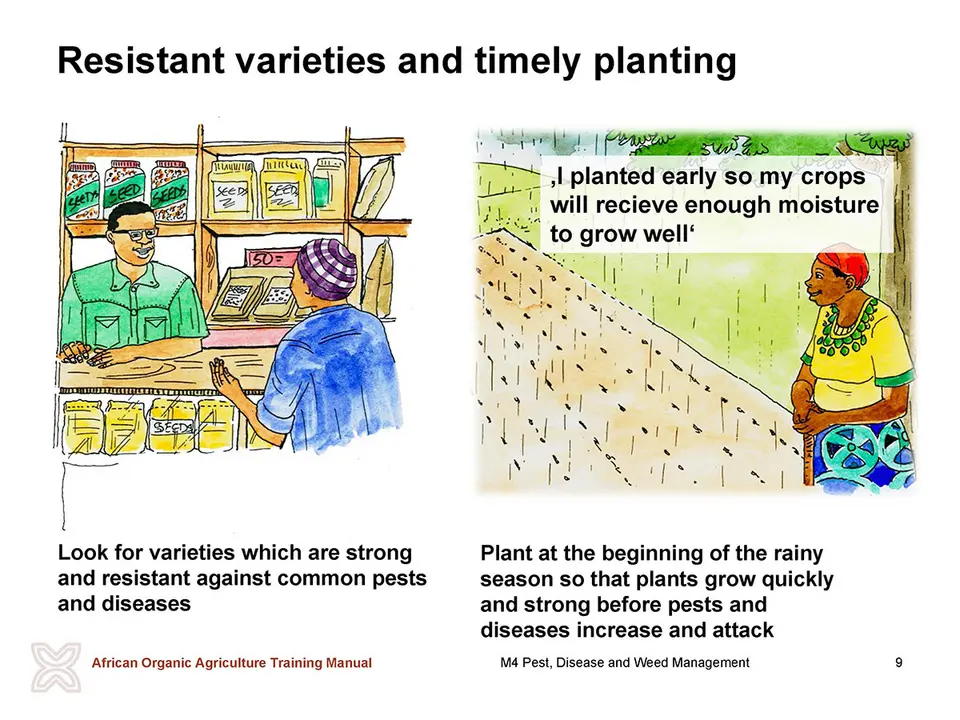
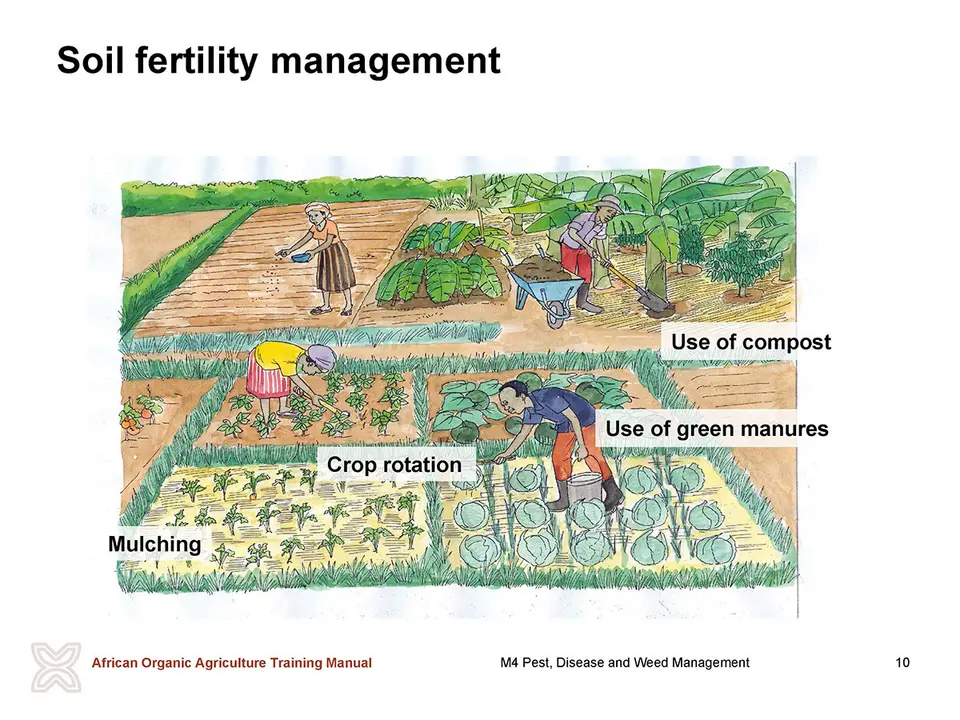
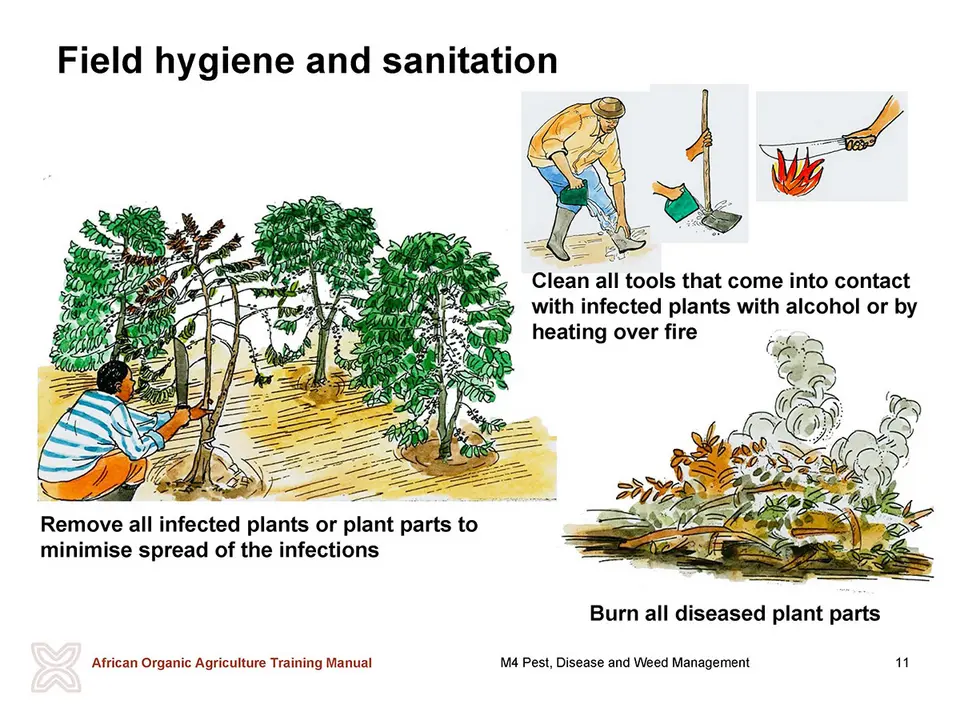
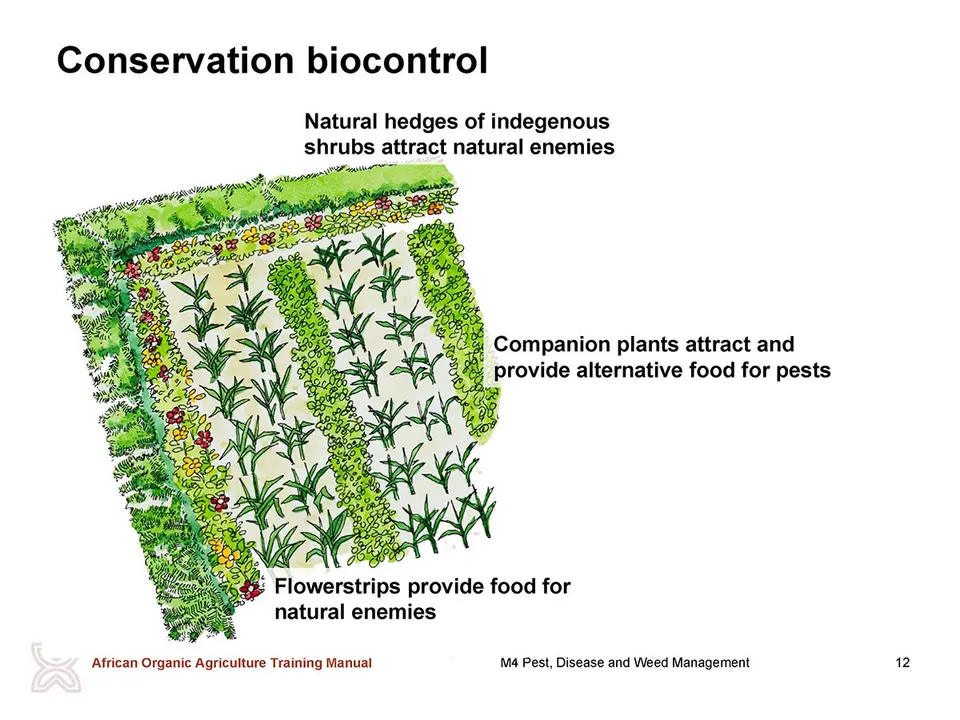
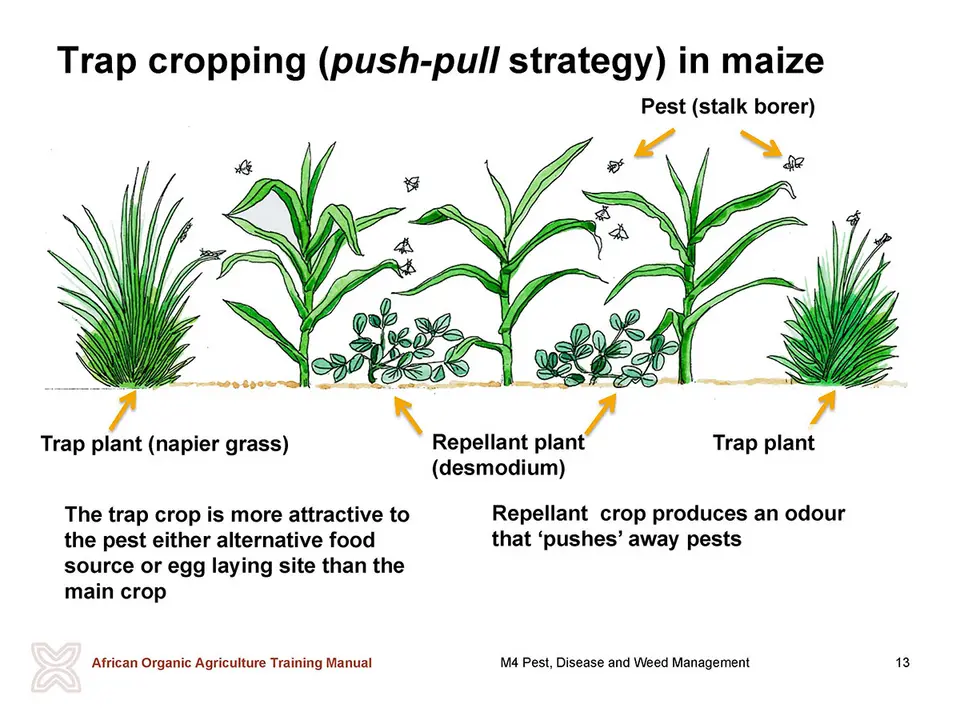
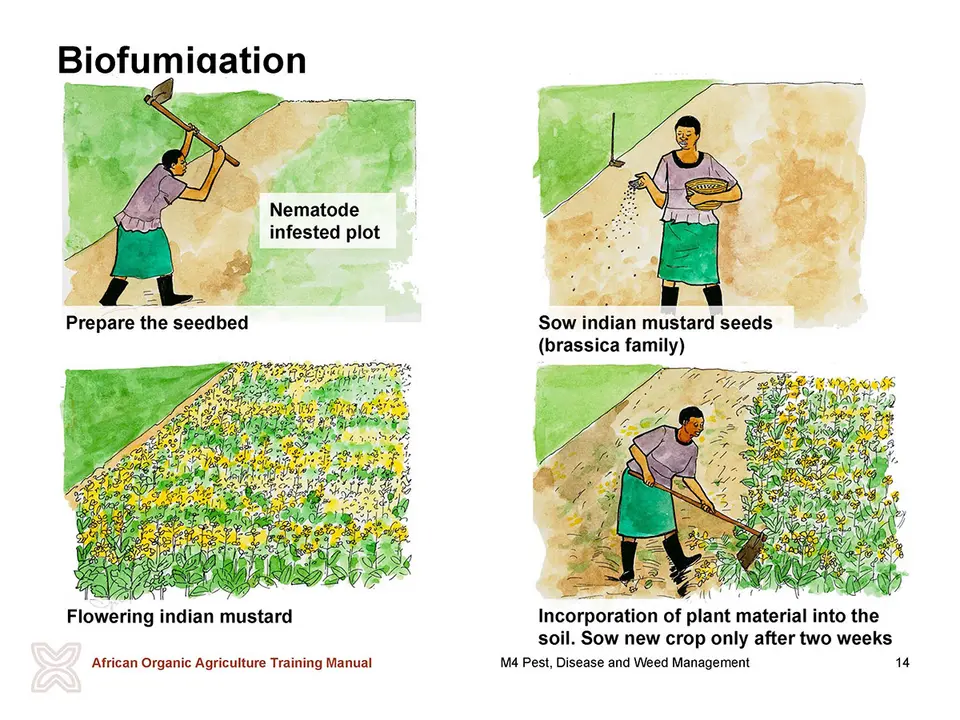
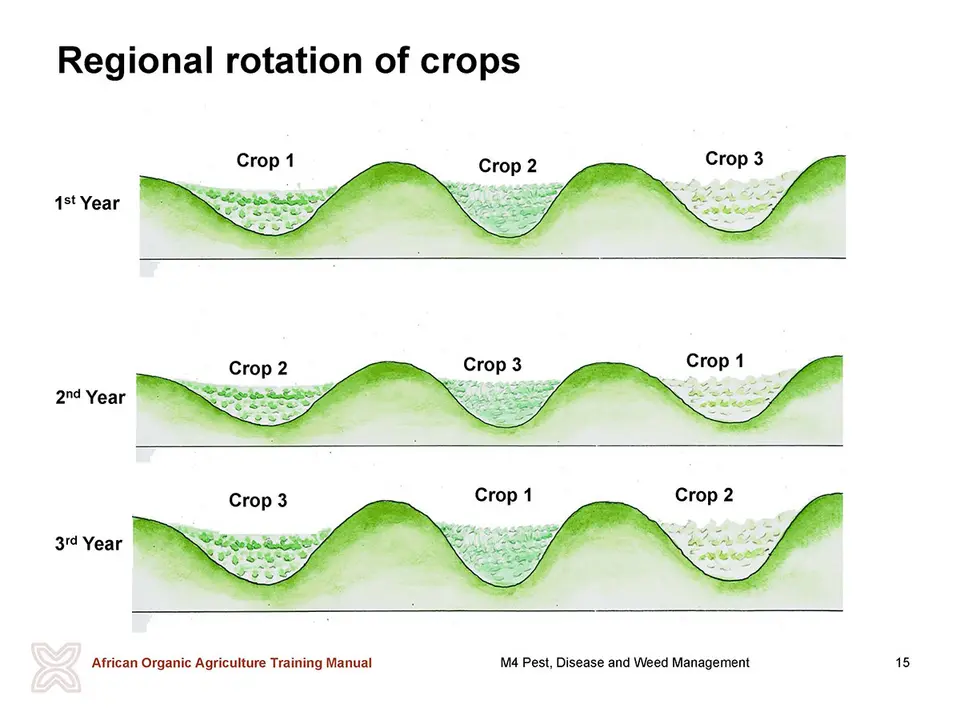
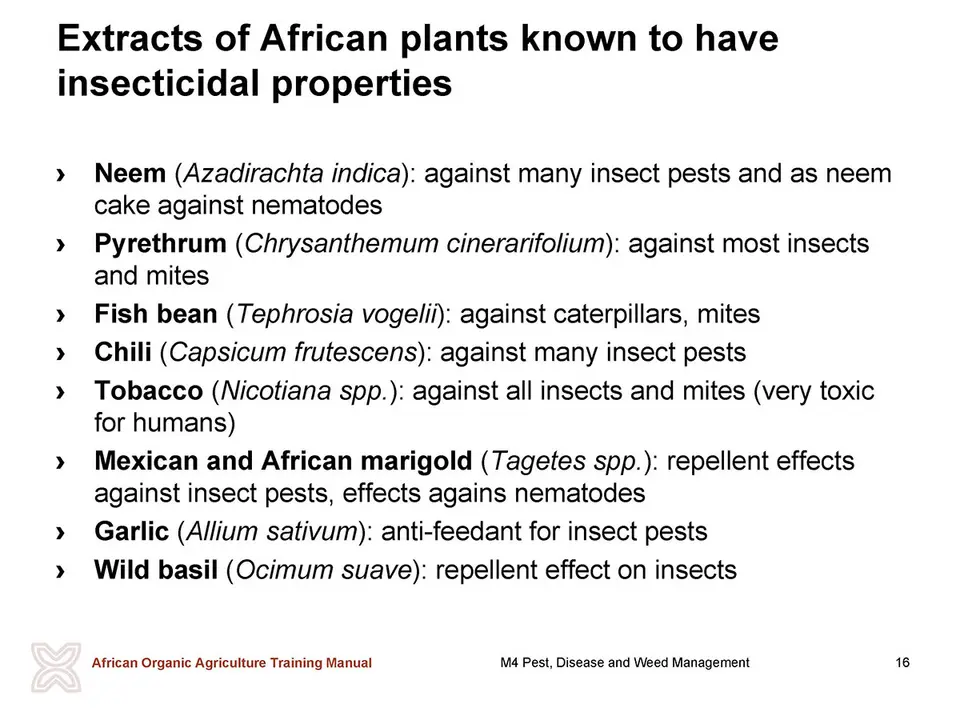
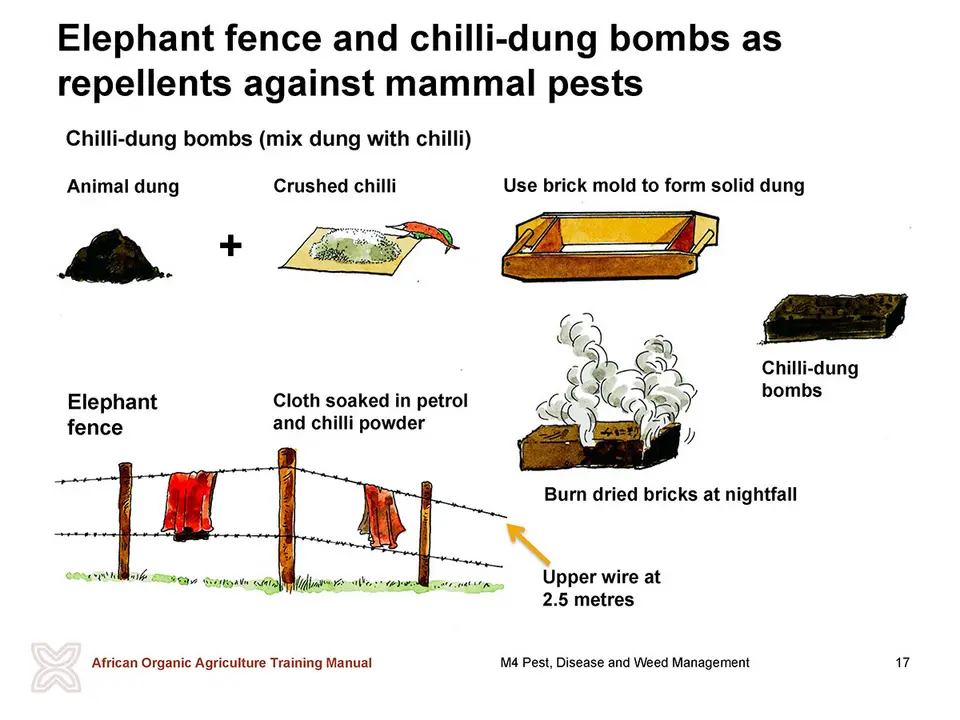
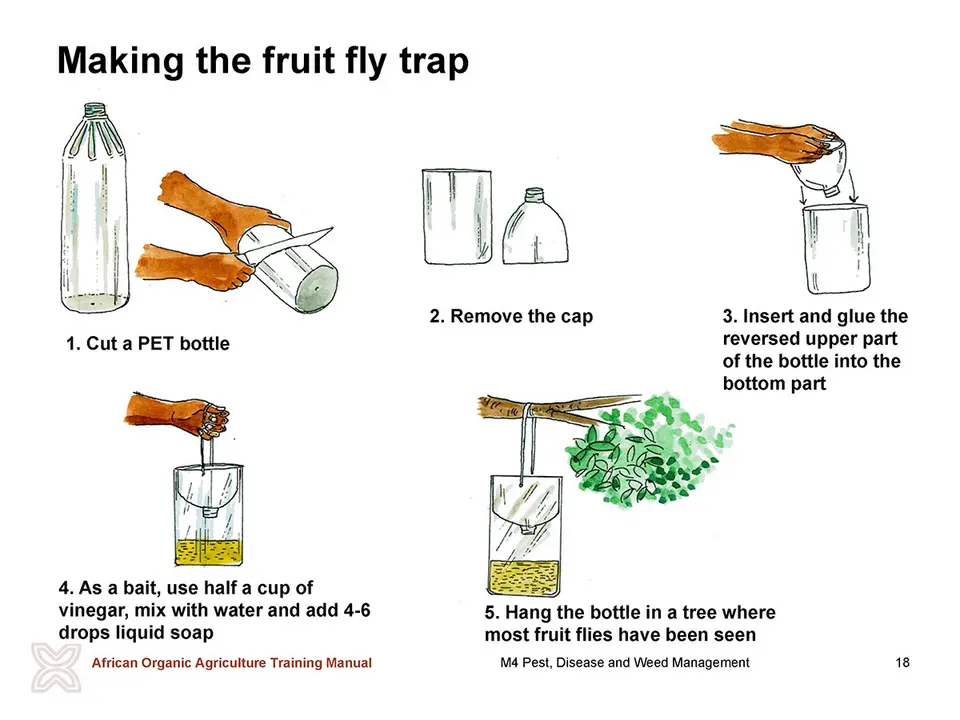
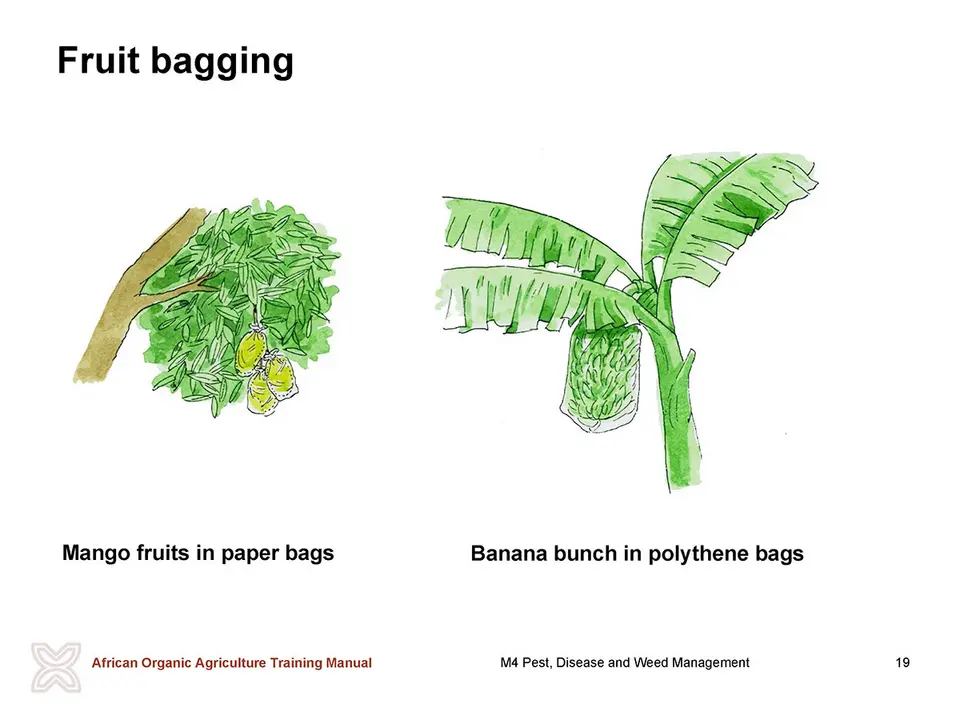
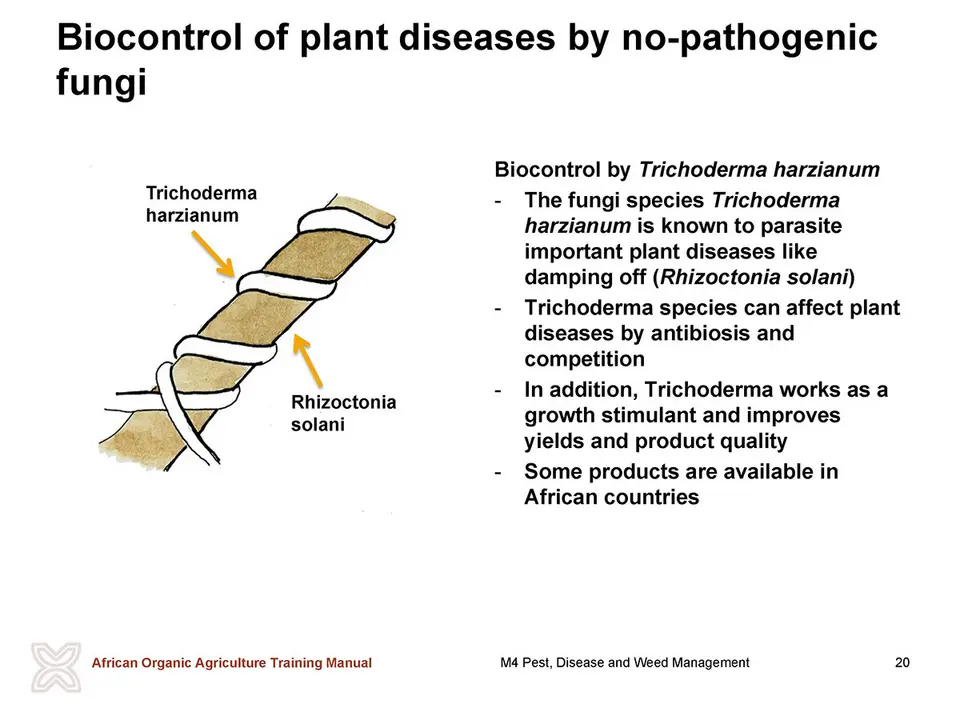
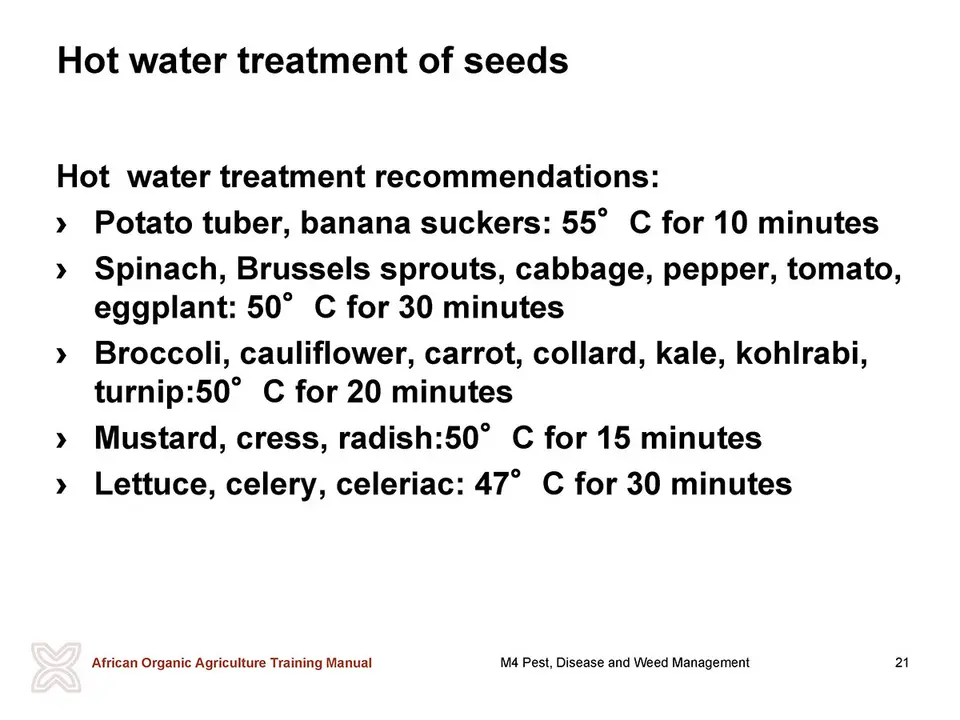
 tap and then scroll down to the Add to Home Screen command.
tap and then scroll down to the Add to Home Screen command.